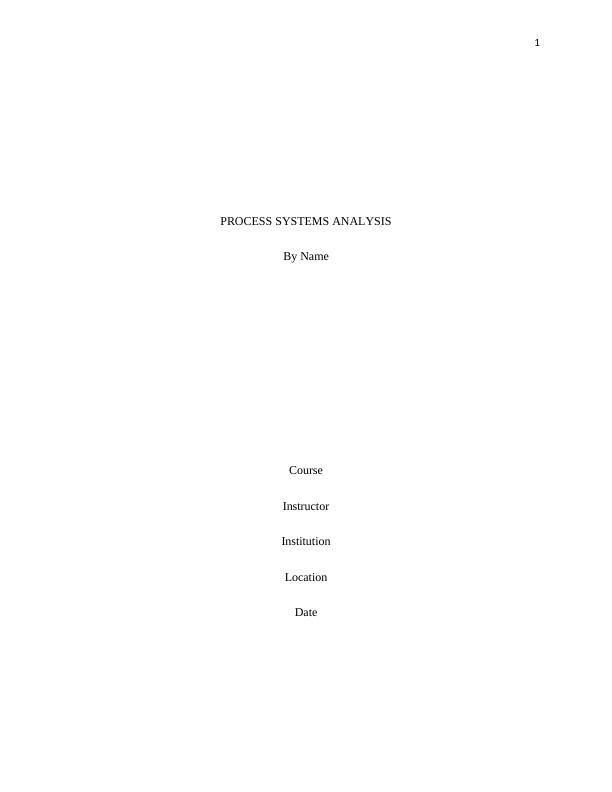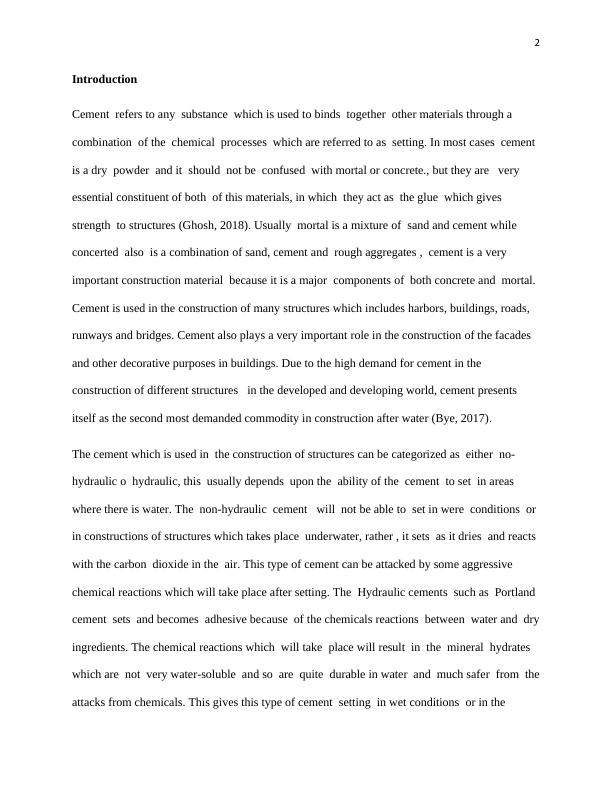Process Systems Analysis
Added on 2023-01-16
16 Pages2992 Words91 Views
1
PROCESS SYSTEMS ANALYSIS
By Name
Course
Instructor
Institution
Location
Date
PROCESS SYSTEMS ANALYSIS
By Name
Course
Instructor
Institution
Location
Date

2
Introduction
Cement refers to any substance which is used to binds together other materials through a
combination of the chemical processes which are referred to as setting. In most cases cement
is a dry powder and it should not be confused with mortal or concrete., but they are very
essential constituent of both of this materials, in which they act as the glue which gives
strength to structures (Ghosh, 2018). Usually mortal is a mixture of sand and cement while
concerted also is a combination of sand, cement and rough aggregates , cement is a very
important construction material because it is a major components of both concrete and mortal.
Cement is used in the construction of many structures which includes harbors, buildings, roads,
runways and bridges. Cement also plays a very important role in the construction of the facades
and other decorative purposes in buildings. Due to the high demand for cement in the
construction of different structures in the developed and developing world, cement presents
itself as the second most demanded commodity in construction after water (Bye, 2017).
The cement which is used in the construction of structures can be categorized as either no-
hydraulic o hydraulic, this usually depends upon the ability of the cement to set in areas
where there is water. The non-hydraulic cement will not be able to set in were conditions or
in constructions of structures which takes place underwater, rather , it sets as it dries and reacts
with the carbon dioxide in the air. This type of cement can be attacked by some aggressive
chemical reactions which will take place after setting. The Hydraulic cements such as Portland
cement sets and becomes adhesive because of the chemicals reactions between water and dry
ingredients. The chemical reactions which will take place will result in the mineral hydrates
which are not very water-soluble and so are quite durable in water and much safer from the
attacks from chemicals. This gives this type of cement setting in wet conditions or in the
Introduction
Cement refers to any substance which is used to binds together other materials through a
combination of the chemical processes which are referred to as setting. In most cases cement
is a dry powder and it should not be confused with mortal or concrete., but they are very
essential constituent of both of this materials, in which they act as the glue which gives
strength to structures (Ghosh, 2018). Usually mortal is a mixture of sand and cement while
concerted also is a combination of sand, cement and rough aggregates , cement is a very
important construction material because it is a major components of both concrete and mortal.
Cement is used in the construction of many structures which includes harbors, buildings, roads,
runways and bridges. Cement also plays a very important role in the construction of the facades
and other decorative purposes in buildings. Due to the high demand for cement in the
construction of different structures in the developed and developing world, cement presents
itself as the second most demanded commodity in construction after water (Bye, 2017).
The cement which is used in the construction of structures can be categorized as either no-
hydraulic o hydraulic, this usually depends upon the ability of the cement to set in areas
where there is water. The non-hydraulic cement will not be able to set in were conditions or
in constructions of structures which takes place underwater, rather , it sets as it dries and reacts
with the carbon dioxide in the air. This type of cement can be attacked by some aggressive
chemical reactions which will take place after setting. The Hydraulic cements such as Portland
cement sets and becomes adhesive because of the chemicals reactions between water and dry
ingredients. The chemical reactions which will take place will result in the mineral hydrates
which are not very water-soluble and so are quite durable in water and much safer from the
attacks from chemicals. This gives this type of cement setting in wet conditions or in the

3
constructions which takes place underwater and at the same time protects the hardened
material from the chemical attacks. The chemical process for the hydraulic cement which
was discovered by the ancient Romans made application of the volcanic ash (UN-HABITAT,
2017).
Raw materials for cement manufacture
The first step which is involved in the construction of cement is to the required raw materials so
that the resulting cement will have the required chemical properties. The raw materials are
ground into small particles in order to make them more blended together, more reactive and
then the resulting raw mix is fed into a cement kiln which heat the raw mix .
Since the final composition and properties of the cement which is produced are specified
within strict bounds , it might be necessary that the requirements for the raw mix would be
similarly strict. While it is very essential to have the correct proportions of silicon, calcium, iron
and aluminum, the overall chemical composition and the structure of the individual raw
ingredients can vary considerably. The main reason behind this is that at very high
temperatures in the kiln, majority of the chemical components of the raw materials are burnt
off and replaced with oxygen from the air (Bhatty, 2012). The table below list some of the
possible raw materials which can used to offer each of the main cement elements.
constructions which takes place underwater and at the same time protects the hardened
material from the chemical attacks. The chemical process for the hydraulic cement which
was discovered by the ancient Romans made application of the volcanic ash (UN-HABITAT,
2017).
Raw materials for cement manufacture
The first step which is involved in the construction of cement is to the required raw materials so
that the resulting cement will have the required chemical properties. The raw materials are
ground into small particles in order to make them more blended together, more reactive and
then the resulting raw mix is fed into a cement kiln which heat the raw mix .
Since the final composition and properties of the cement which is produced are specified
within strict bounds , it might be necessary that the requirements for the raw mix would be
similarly strict. While it is very essential to have the correct proportions of silicon, calcium, iron
and aluminum, the overall chemical composition and the structure of the individual raw
ingredients can vary considerably. The main reason behind this is that at very high
temperatures in the kiln, majority of the chemical components of the raw materials are burnt
off and replaced with oxygen from the air (Bhatty, 2012). The table below list some of the
possible raw materials which can used to offer each of the main cement elements.

4
Fig: Raw ingredients used to provide each of the main cement elements (Winter, 2011)
The raw materials which are listed above includes both the naturally occurring materials
such as clay and limestone and the industrial by products such as fly ash and slag. From the
table above it may seem as if just about any material which contains one of the key elements
of cement can be tossed into the cement kiln, but usually that is not the case. Usually the raw
materials which contains more than minor or in some cases traces amount of the metallic
elements such as magnesium, strontium, magnesium, potassium and different heavy metals
which cannot be used , since they will not be able to off in the kiln and at the same time they
will have a negative effect on the cement,. Another consideration regarding to the selection of
the raw material for the manufacture of cement is the reactivity of the raw material (Christome,
2016). This is a function of both the chemical structures and the fitness of the raw material. Clay
is an ideal raw material since it is made up of fine particles already and hence there will be
need for little before being used in the manufacture of cement. Clay is also the most common
Fig: Raw ingredients used to provide each of the main cement elements (Winter, 2011)
The raw materials which are listed above includes both the naturally occurring materials
such as clay and limestone and the industrial by products such as fly ash and slag. From the
table above it may seem as if just about any material which contains one of the key elements
of cement can be tossed into the cement kiln, but usually that is not the case. Usually the raw
materials which contains more than minor or in some cases traces amount of the metallic
elements such as magnesium, strontium, magnesium, potassium and different heavy metals
which cannot be used , since they will not be able to off in the kiln and at the same time they
will have a negative effect on the cement,. Another consideration regarding to the selection of
the raw material for the manufacture of cement is the reactivity of the raw material (Christome,
2016). This is a function of both the chemical structures and the fitness of the raw material. Clay
is an ideal raw material since it is made up of fine particles already and hence there will be
need for little before being used in the manufacture of cement. Clay is also the most common

End of preview
Want to access all the pages? Upload your documents or become a member.
Related Documents
Selection of Building Materials: Manufacturing Process, Onsite Installation, Tests, Advantages and Disadvantageslg...
|10
|543
|311
Construction Defects Assignment PDFlg...
|8
|1596
|201
Materials Science in Construction: Honeycomb Defect and Its Solutionlg...
|8
|1732
|68
Supplementary Cementious Materials Assignmentlg...
|12
|3296
|31
Selection of Building Materials: Raw Materials, Manufacturing Process, Onsite Installation, Testing Techniques, Advantages and Disadvantageslg...
|13
|2197
|249
Importance of Curing Concrete and Underwater Concreting Techniqueslg...
|18
|3218
|244